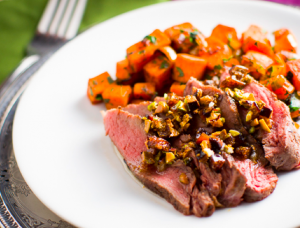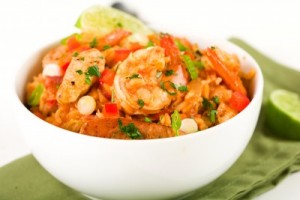Slap Yo Daddy’s Sous Vide Beef Rendang
Courtesy of Harry Soo of Slap Yo’ Daddy BBQ
Winner Fan Favorite, 2013 Summer BBQ Challenge
Serves 4
INGREDIENTS
For the stew beef

- 2 pounds (0.9 kg) stew beef (brisket works well)
- 1 tablespoon (15 ml) SYD (Slap Yo’ Daddy) Hot Rub or salt and pepper
For the spice paste
- 5 tablespoons (60 g) finely minced lemon grass, white part only (discard any tough parts)
- 4 teaspoons (20 ml) peeled, chopped garlic
- 8 shallots, peeled and chopped
- 2 tablespoons (30ml) ground toasted coriander seed or coriander powder
- 2 tablespoons (30 ml) mild chili powder
- ½ cup (120 ml) canola oil, and more as needed to sauté the spice paste so it does not burn
For the liquid ingredients
- 8 tablespoons (120 ml) premium coconut milk (use only the cream part by letting a can of coconut milk sit for a day; open the can gently and skim off the thick coconut cream portion and discard the watery part)
- 2 teaspoons (10 ml) fish sauce
- 4 teaspoons (20 ml) sugar
- 1 teaspoon (5 ml) cinnamon
- 4 teaspoons (20 ml) tamarind paste (available online or at Indian grocery stores)
For the aromatics
- 2 cinnamon sticks
- Thai or Serrano chilies, as many as you like
- 8 whole cloves
- 6 whole cardamom pods (from Indian grocery store)
- 6 kaffir lime leaves or substitute with lime zest (available at Asian or Thai grocery stores)
For serving
- 4 tablespoons (60 ml) toasted grated coconut
- 4 cups (650 g) steamed jasmine rice, for serving
INSTRUCTIONS
- Fill and preheat the SousVide Supreme to 150F/65.5C.
- Preheat an oiled grill to high heat (or if you prefer, a smoke pit to 275F/74C.)
- Dice the beef into 1-inch (2.5 cm) cubes.
- Sprinkle the beef with some SYD Hot Rub or just salt and pepper.
- Put the beef onto the grill and quickly char the outside surface or smoke in the pit for 30 minutes. Set aside.
- Put all spice paste ingredients into a food processor and pulse. With the motor running, drizzle in enough canola oil to allow the spices to blend into a paste.
- On the stovetop, warm 2 tablespoons of the canola oil over gentle heat in a sauté pan.
- Transfer the spice paste to the sauté pan and sauté the spice mix until the oil begins to separate and the spice paste turns brown and fragrant (about 15-20 minutes). Set pan aside to cool.
- Mix the liquid ingredients in a bowl. Add the spice paste, browned meat, and aromatics. Stir thoroughly to coat the meat all over.
- Put the meat, spice paste, liquids, and aromatics into a large (gallon/3.8 liter) sous vide cooking pouch and vacuum seal. Take care not to pull liquid into the suction chamber, if using a suction vacuum sealer.
- Submerge in the water oven and cook for 2 to 3 days (48 to 72 hours) or more depending on how tender you prefer your beef.
- Remove the pouch, cut open, taste and adjust seasonings with salt and pepper.
- Mix in the toasted coconut flakes before serving with some steamed jasmine rice. Enjoy!








 Easy Returns & Exchanges
Easy Returns & Exchanges Shipping Rates & Info
Shipping Rates & Info Satisfaction Guarantee
Satisfaction Guarantee Contact Us
Contact Us Email your questions to
Email your questions to 
